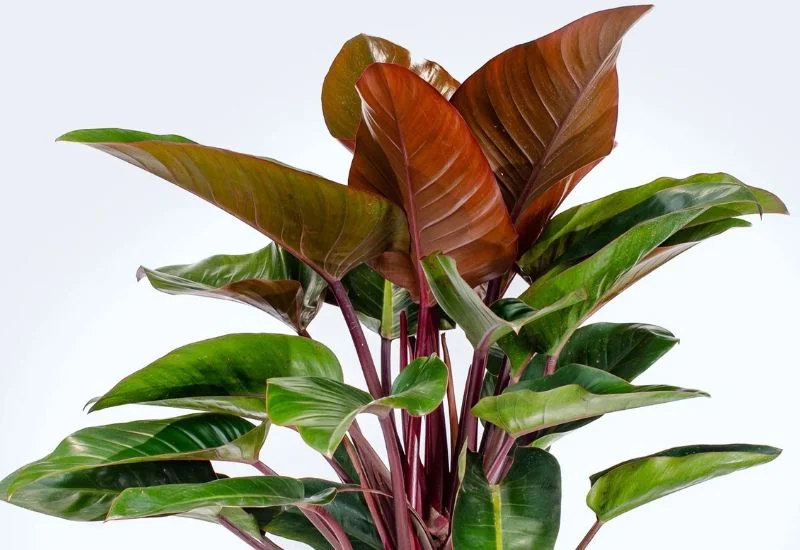In this blog post, you’re going to learn how to easily propagate and care for Philodendron Rojo Congo.
This is a comprehensive guide covering reliable information about different aspects of this cultivated variety.
In this post, I’ll cover:
Interesting Facts
Propagation
Repotting
Care
And
Solutions to Common Problems
So, if you are looking to propagate and care for Philodendron Rojo Congo, this guide is for you.
Fun Facts
| Common Name | Rojo Philodendron, Congo Rojo, Red Congo |
| Botanical Name | Philodendron tatie “Rojo Congo” |
| Family | Araceae |
| Plant Type | Perennial |
| Fruit | Berry like (Very rare) |
| Mature Size | 3 ft. height and width |
| Sun Exposure | Partial Exposure (Bright and Indirect Light) |
| Soil Type | Almost all types of soil (moist and well draining is preferred) |
| Soil pH | Slightly acidic |
| Native Area | South America |
| Toxic | Toxic to human and pets |
| Growth | Fast growing |
The Philodendron Rojo Congo is an eye-catching, beautiful houseplant. This hybrid from the Philodendron family requires little care and is suitable for indoor cultivation without specific attention.
The most prominent feature of Philodendron Rojo Congo is its lively-coloured leaves, which play a great role in its ornamental function. These are large, bright-flowering, heart-shaped leaves. Initially, the leaves are reddish (deep sensational) and then become green on maturity. Most of the leaves have large, meat-like margins, which give the plant a sturdy look.
The Philodendron Rojo Congo is comparatively easy to grow and propagates very fast if placed in warm and moist conditions. Under ideal climatic conditions, it thrives well and reaches its maximum potential. From spring through summer, which is mostly regarded as the growing season, the plant experiences growth and develops new leaves.
Flowers and Fruits in Philodendron Rojo Congo

The primary bloom of this Philodendron Rojo Congo is inconspicuous and not always the focus of the plant’s visual interest. It bears a spathe and spadix within its flowering structure. The spathe, being a leaf-like structure, covers the spadix, the actual flowering structure. The spathe of the Rojo Congo is green to reddish, which attracts the spectator.
P. Rojo Combo rarely produces berry-like fruit for natural propagation.
Benefits
Here are some attractive advantages of this Philodendron;
Low Maintenance
The Philodendron Rojo Congo is relatively low maintenance and will be an excellent fit for a beginner with little or no plant-keeping background.
Aesthetic Appearance
Therefore, its key value lies in the large, brightly colored, deeply lobed leaves of bright red; they make Rojo Congo a very attractive plant. The plant’s colorful shades contribute to giving the interiors a classy look and feel.
Air Purification
Like most other philodendrons, it can identify poisonous substances in the air and remove them, making a healthy addition to homes and offices.
Pets and Disease Resistance
This plant is relatively immune to most pests and diseases, so it cannot be often treated with chemicals. This aspect adds to its low maintenance advantage.
Long Lasting Foliage
Rojo Congo holds its leaves so they do not wilt, and they are thick. This longevity makes the plant retain its appeal throughout the year.
Humidity Regulation
It is a tropical plant, so it can release moisture into the air. This helps to maintain the necessary humidity indoors, which can be useful in dry climates or during the winter months when the sun is weak.
Growth Potential
Rojo Congo is not a compact plant; with time, it can develop into a large plant, giving a tone to the room. It increases interior design’s interaction, creativity, and vitality of the space.
Increased Productivity
Rojo Congo enhances concentration and productivity. So, it is recommended for use in offices or areas where the study is conducted.
Educational Value
Any lover of plants, as well as botany students, should find the Rojo Congo to be a fine example of Tropical plant biology. Moreover, it’s interesting to study iillustration of its leaves and growth patterns.
